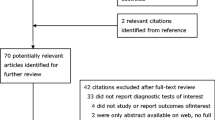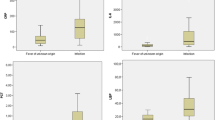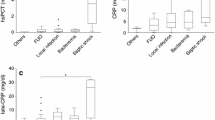Abstract
Objective and design
The aim of this study was to assess the value of procalcitonin (PCT), C-reactive protein (CRP), tumor necrosis factor-alpha (TNF-a), interleukin (IL)-1b, IL-8, and soluble TNF receptor II (sTNFRII) in early and rapid diagnosis of infection in neutropenic children with acute lymphoblastic leukemia (ALL) and to distinguish bacterial from viral infections.
Patients
The study included five groups (A, B, C, D, and E) of children with ALL undergoing intensive chemotherapy. Groups A and B consisted of neutropenic children with bacterial and viral infection, respectively. Groups C and D consisted of nonneutropenic children with bacterial and viral infection, respectively. Group E consisted of children without neutropenia and without fever.
Methods
In all groups, blood samples were collected upon admission and then for 7 days on a daily basis. Levels of CRP, PCT, TNF-a, IL-1b, IL-8, and sTNFRII were determined in all blood samples.
Results
We found a highly significant difference in PCT levels between bacterial and nonbacterial episodes. Sensitivity and specificity of PCT were 94 and 96.5%, respectively.
Conclusions
Serial measurement of PCT levels on a daily basis seems to be helpful for early prediction of severe bacterial infections, monitoring febrile episodes regarding response to antibiotic therapy, and early detection of complications in the infectious process.







Similar content being viewed by others
References
Finberg RW, Talcott JA. Fever and neutropenia-how to use a new treatment strategy. N Engl J Med. 1999;341(5):362–8.
Crokaert F. Febrile neutropenia in children. Int J Antimicrob Agent. 2000;16:173–7.
Schimpff SC. Infections in the cancer patients-diagnosis, prevention and treatment. In: Mandell GL, Douglas RG, Bennet JE, editors. Principles and practice of infectious diseases. New York: Churchill Livingstone; 1995. p. 2666.
Laws HJ, Schneider DT, Janssen G, Wessalowski R, Dilloo D, Meisel R, et al. Trends in infections in children with malignant disease in 2000: comparison of data of 1980/81. Pediatr Hematol Oncol. 2000;24(5):343–54.
Von Lilienfeld-Toal M, Dietrich MP, Glasmacher A, Lehmann L, Breig P, Hahn C, et al. Markers of bacteremia in febrile neutropenic patients with hematological malignancies: procalcitonin and IL-6 are more reliable than C-reactive protein. Eur J Clin Macrobiol Infect Dis. 2004;23:539–44.
Hitoglou S, Hatzistilianou M, Gougoustamou D, Athanassiadou F, Kotsis A, Catriu D. Adenosine deaminase activity and isozyme levels in serum and peripheral blood lymphocytes in childhood acute lymphoblastic leukemia. Mol Immunol. 1998;35(11–12):754–9.
Petrola V, Toikka P, Irjala K, Mertsola J, Ruuskanen O. Discrepancy between total white blood cell count and serum C-reactive protein levels in febrile children. Scand J Infect Dis. 2007;39(6):560–5.
Kalio R, Bloigu A, Surcel HM, Syrjiada H. C-reactive protein and erythrocyte sedimentation rate in differential diagnosis between infections and neoplastic fever in patients with solid tumours and lymphomas. Support Care Cancer. 2001;9:124–9.
Hartel C, Deutser M, Lehrnbecher T, Schultz C. Current approaches for risk stratification of infectious complications in pediatric oncology. Pediatr Blood Cancer. 2007;49(6):767–73.
Sheu JN, Chen MC, Lue KH, Sl Cheng, Lee IC, Chen SM, et al. Serum and urine levels of interleukin-6 and interleukin-8 in children with acute pyelonephritis. Cytokine. 2006;36(5–6):276–82.
Shereen Mohamed EM, Manar Mohamed M, Manar Mohamed I, Lobna M, Hadir A. The diagnostic value of C-reactive protein, interleukin-8, and monocyte chemotactic protein in risk stratification of febrile neutropenic children with hematologic malignancies. J Pediatr Hematol Oncol. 2007;29(3):131–6.
Lehrnbecher T, Venzon D, de Haas M, Chanock SJ, Kuel J. Assessment of measuring circulating levels of interleukin-6, interleukin-8, C-reactive protein, soluble Fc gamma receptor type III, and mannose-binding protein in febrile children with cancer and neutropenia. Clin Infect Dis. 1999;29:414–9.
Nijsten MW, Olinga P, The TH, de Vries EG, Koops HS. Procalcitonin behaves as a fast responding acute phase protein in vivo and in vitro. Crit Care Med. 2000;28:458–61.
Hoffmann G, Schobersberger W. Procalcitonin as a marker. Acta Anaesthesiol Scand. 2003;47(2):237–43.
Gendel D, Bohuon C. Procalcitonin a marker of bacterial infection. Infection. 1997;25:133–8.
Whang KT, Steinwald PM, White JC. Serum calcitonin precursors in sepsis and systemic inflammation. J Clin Endocrinol Metab. 1998;83:3296–301.
Emporiadou M, Hatzistilianou M, Haidopoulou K, Aggouridaki C, Reklity A, Magnisali C, et al. Procalcitonin and inflammatory cytokines in children with asthma. Eur J Inflamm. 2005;3(2):75–81.
Bernard L, Ferriere F, Casassus P, Malas E, Leveque S, Guillevin L. Procalcitonin as an early marker of bacterial infection in severely neutropenic febrile adults. Clin Infect Dis. 1998;27:914–7.
Hatzistilianou M, Hitoglou S, Gougoustamou D, Rekliti A, Tzouvelekis G, Nanas C, et al. Serum procalcitonin, adenosine deaminase and its isoenzymes in the aetiological diagnosis of pneumonia in children. Int J Immunopathol Pharmacol. 2002;15(2):119–23.
The Immunocompromised Host Society. The design, analysis, and reporting of clinical trials on the empirical antibiotic management of the neutropenic patient. J Infect Dis. 1990;161:397–404.
Alexander SW, Pizzo PA. Current considerations in the management of fever and neutropenia. In: Remington JS, Swartz MN, editors. Current clinical topics in infectious diseases. Oxford: Blackwell; 1999. p. 160–80.
Hughes WT, Armstrong D, Bodey GP, Brown AE, Edwards JE, Feld R, et al. Guidelines for the use of antimicrobial agents in neutropenic patients with unexplained fever. Clin Infect Dis. 1997;25:551–5.
Penel N, Fournier C, Clisant S, N’Guyen M. Causes of fever and value of C-reactive protein and procalcitonin in differentiating infections from paraneoplastic fever. Support Care Cancer. 2004;12:593–7.
Ruokonen E, Nousiainen T, Pulkki K, Takala J. Procalcitonin concentrations in patients with neutropenic fever. Eur J Clin Microbiol Infect Dis. 1999;18:283–8.
Schuttrump S, Binder L, Hagemann T, Berkovie D, Trumper L, Binder C. Procalcitonin: a useful discriminator between febrile conditions of different origin in hemato-oncological patients? Ann Hematol. 2003;82:98–101.
Hitoglou S, Hatzistilianou M, Gougoustamou D, Rekliti A, Agguridaki Ch, Athanassiadou F, et al. Serum adenosine deaminase and procalcitonin concentrations in neutropenic febrile children with acute lymphoblastic leukemia. Clin Exp Med. 2005;5:60–5.
Christ-Crain M, Jaccard-Stolz D, Bingisser R, Gencay M, Huber P, Tamm M, et al. Effect of procalcitonin-guided treatment on antibiotic use and outcome in lower respiratory tract infections: cluster-randomised, single-blinded intervention trial. Lancet. 2004;363:600–5.
Hatzistilianou M, Rekleity A, Athanassiadou F, Delutils MA, Conti P, Catriu D. Serial procalcitonin responses in infection of children with secondary immunodeficiency. Clin Invest Med. 2007;30(2):75–85.
Mitaka C. Clinical laboratory differentiation of infectious versus non-infectious systemic inflammatory response syndrome. Clin Chim Acta. 2005;351(1–2):17–21.
Chesney J, Metz C, Stavitsky AB, Bacher M, Bacher R. Regulated production of type I collagen and inflammatory cytokines by peripheral blood fibrocytes. J Immunol. 1998;160:419–25.
Harbarth S, Holechova K, Froidevaux C, Pittet D, Ricou B, Grau G, et al. Diagnostic value of procalcitonin, interleukin-6 and interleukin-8 in critically III patients admitted with suspected sepsis. J Resp Crit Care Med. 2001;164(3):396–402.
Fleischhack G, Kambeck I, Cipic D, Hasan C, Bode U. Procalcitonin in paediatric cancer patients: its diagnostic relevance is superior to that of C-reactive protein, interleukin 6, interleukin 8, soluble interleukin 2 receptor and soluble necrosis factor receptor II. Br J Haematol. 2000;111:1093–102.
Author information
Authors and Affiliations
Corresponding author
Additional information
Responsible Editor: K. Visvanathan.
Rights and permissions
About this article
Cite this article
Hatzistilianou, M., Rekliti, A., Athanassiadou, F. et al. Procalcitonin as an early marker of bacterial infection in neutropenic febrile children with acute lymphoblastic leukemia. Inflamm. Res. 59, 339–347 (2010). https://doi.org/10.1007/s00011-009-0100-0
Received:
Revised:
Accepted:
Published:
Issue Date:
DOI: https://doi.org/10.1007/s00011-009-0100-0




